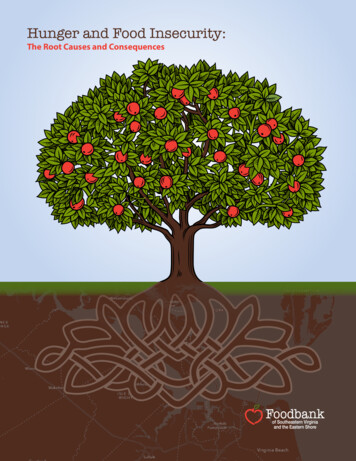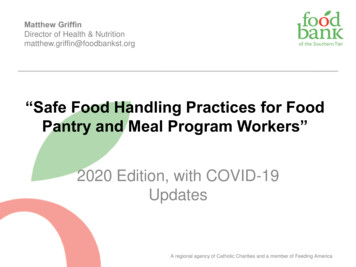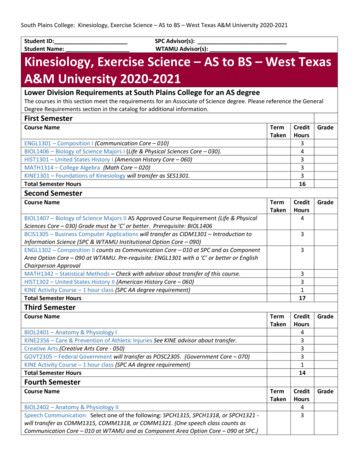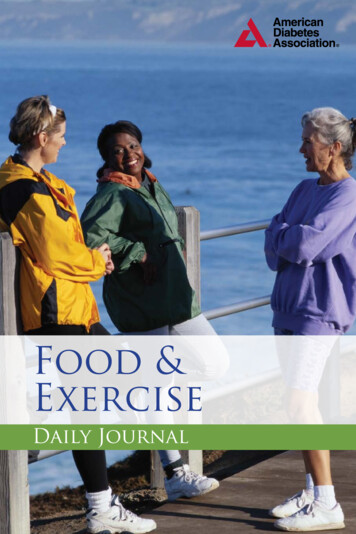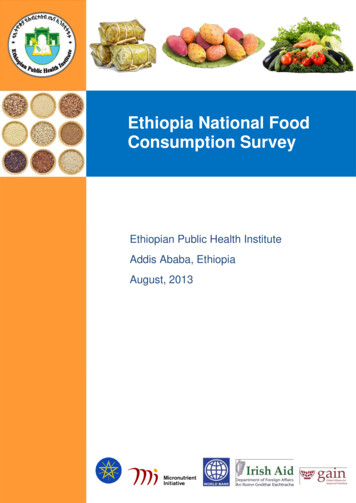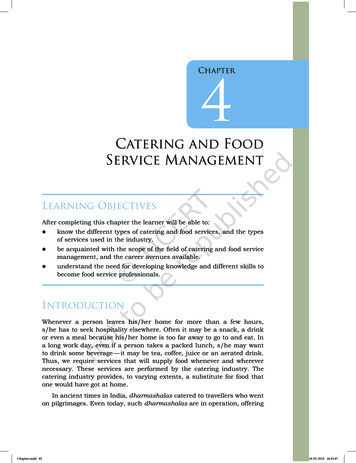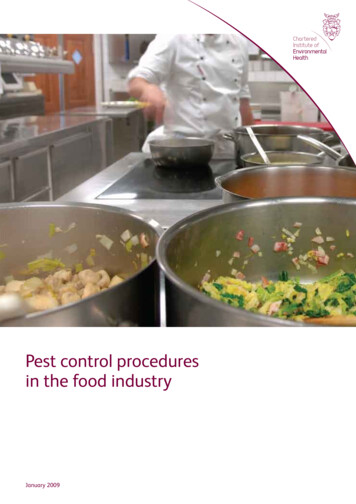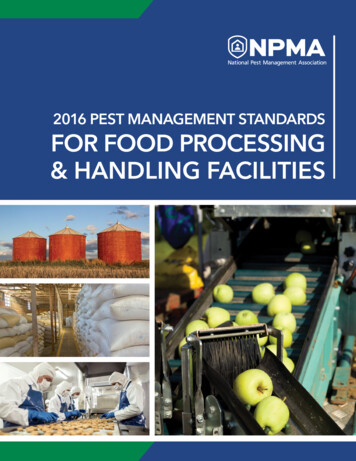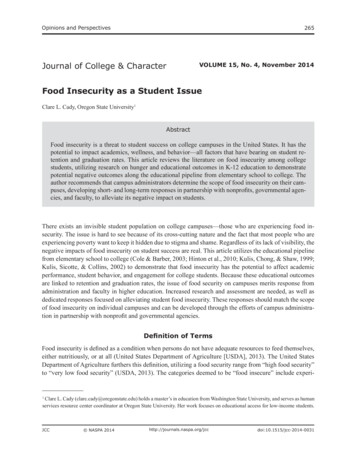
Transcription
Opinions and Perspectives265Journal of College & CharacterVOLUME 15, No. 4, November 2014Food Insecurity as a Student IssueClare L. Cady, Oregon State University1AbstractFood insecurity is a threat to student success on college campuses in the United States. It has thepotential to impact academics, wellness, and behavior—all factors that have bearing on student retention and graduation rates. This article reviews the literature on food insecurity among collegestudents, utilizing research on hunger and educational outcomes in K-12 education to demonstratepotential negative outcomes along the educational pipeline from elementary school to college. Theauthor recommends that campus administrators determine the scope of food insecurity on their campuses, developing short- and long-term responses in partnership with nonprofits, governmental agencies, and faculty, to alleviate its negative impact on students.There exists an invisible student population on college campuses—those who are experiencing food insecurity. The issue is hard to see because of its cross-cutting nature and the fact that most people who areexperiencing poverty want to keep it hidden due to stigma and shame. Regardless of its lack of visibility, thenegative impacts of food insecurity on student success are real. This article utilizes the educational pipelinefrom elementary school to college (Cole & Barber, 2003; Hinton et al., 2010; Kulis, Chong, & Shaw, 1999;Kulis, Sicotte, & Collins, 2002) to demonstrate that food insecurity has the potential to affect academicperformance, student behavior, and engagement for college students. Because these educational outcomesare linked to retention and graduation rates, the issue of food security on campuses merits response fromadministration and faculty in higher education. Increased research and assessment are needed, as well asdedicated responses focused on alleviating student food insecurity. These responses should match the scopeof food insecurity on individual campuses and can be developed through the efforts of campus administration in partnership with nonprofit and governmental agencies.Definition of TermsFood insecurity is defined as a condition when persons do not have adequate resources to feed themselves,either nutritiously, or at all (United States Department of Agriculture [USDA], 2013). The United StatesDepartment of Agriculture furthers this definition, utilizing a food security range from “high food security”to “very low food security” (USDA, 2013). The categories deemed to be “food insecure” include experi-Clare L. Cady (clare.cady@oregonstate.edu) holds a master’s in education from Washington State University, and serves as humanservices resource center coordinator at Oregon State University. Her work focuses on educational access for low-income students.1JCC NASPA 014-0031
266Journal of College & CharacterVOLUME 15, No. 4, November 2014ences of reduced caloric intake, quality of foods, lack of variety in diet, disrupted eating patterns, and hunger (USDA, 2013). Current research shows that approximately 14.5% of U.S. households are experiencingsome form of food insecurity (USDA, 2013). For the purposes of this article, I use the term food insecurityto mean any level of deficient food resources along this food security spectrum. I utilize the term foodinsecurity without hunger to indicate times when the issue is lowered caloric intake, lack of food variety,and lower quality of foods. When the issue is specifically not enough food to maintain oneself physically,I utilize the term food insecurity with hunger. When the distinction is not relevant, I will use the term foodinsecurity.Food Insecurity as a Student IssueWhen discussing college student populations, research on the prevalence of food insecurity is limited. Themost recent study published was conducted at a large public university in the southeastern United States.Researchers found 14% of students surveyed were experiencing some form of food insecurity (Gaines,Robb, Knol, & Sickler, 2014). Another recent study was conducted at a rural university in Oregon, whichfound that over half the students surveyed (59%) had experienced food insecurity with or without hunger atsome point during the previous year (Patton-Lopez, Lopez-Cevallos, Cancel-Tirado, & Vazquez, 2014). In astudy done at the University of Hawai’i at Manoa researchers found that 21% of students were considered tobe food insecure (Chaparro, Zaghloul, Holck, & Dobbs, 2009). This study also referenced two unpublishedresearch projects conducted at Ohio University and the University of Hawai’i at Manoa, noting that in thestudy in Hawai’i, 22% of the students surveyed were found to be food insecure. Two other unpublishedstudies found high instances of food insecurity. A student honors project at Bowling Green State Universityfound 19% of surveyed students to be food insecure (Koller, 2014), and a study conducted at the Universityof California, Merced, found that 32% were experiencing either food insecurity with hunger or food insecurity without hunger (Lerer, 2013). Only one study was conducted at a community college. Researchersfrom City University of New York found that 39.2% of students reported experiencing food insecurity, with22.7% reporting food insecurity with hunger (Freudenberg et al., 2011). One limitation of this literaturereview is that the studies are not consistent in how they measure food insecurity and thus cannot easily beused together to paint a broader picture. Additionally, most of the studies did not indicate the type of foodinsecurity (with or without hunger) measured. This limits conclusions that can be drawn from the researchbecause each type of food insecurity could differently impact student outcomes. Also, these studies focusprimarily on the incidence of food insecurity among students without looking deeply into impacts on academics, engagement, success, or retention. Two of the published studies concluded that further research wasneeded along these areas (Chaparro et al., 2009; Hughes, Serebryanikova, Donaldson, & Leveritt, 2011).There exists a dissonance between these studies and what is known about food insecurity in theUnited States. Current national trends show that in 2012, 14.5% of U.S. households were experiencingfood insecurity with or without hunger (USDA, 2013), while the data on college students indicate that foodinsecurity is significantly higher than the general U.S. population. The fact that the number of food insecurecollege students is greater than the national average seems out of sync with data about how poverty impactscollege attendance. Experiencing food insecurity in elementary and high school leads to negative impactson academic outcomes (Alaimo, Olson, & Frongillo, 2001; Bergerson, 2006; Jyoti, Frongillo, & Jones,2005; Rowan, Cohen, & Raudenbush, 2004; Winicki & Jemison, 2003). Because food insecurity negativelyimpacts academic success, it indicates that students who are food insecure across their lifespan are .org/jcc NASPA 2014JCC
Food Insecurity as a Student Issue 267likely to achieve in elementary and high school, thus making it less likely for them to attend a college oruniversity. This potential impact is supported by literature demonstrating that low-income students attendcolleges and universities in fewer numbers than peers who are more financially secure (Astin, 1975, 1993;Hearn, 1984, 1990; Hossler, Schmidt, & Vesper, 1999; Karabel, 1972; McDonough, 1997; Paulsen & St.John, 2002; Tinto, 1987, 1993). Given that the research suggests that there should be fewer food insecurestudents attending colleges and universities, the fact that there seem to be so many students in this situation calls for answers to the questions, “Are these studies accurate?”, and if so, “Why are college studentsexperiencing higher instances of food insecurity than the general U.S. population?”While there are gaps in the data regarding student food insecurity, actions taken at colleges and universities suggest that this is a salient issue for many students. The College and University Food Bank Alliance (CUFBA, 2013), founded in 2012, has identified over 70 campuses on which a food bank exists orwhere one is being started (Cady & Smith-Tyge, 2013), 22 of which have joined the organization (http://www.cufba.org/member-info). This “food bank movement” (Powers, 2012) is one response to the challenges that students are facing due to poverty and hunger. Data used to support these responses are varied.Some food banks were created due to research to identify gaps in community food safety nets, like at Oregon State University (Cunningham & Johnson, 2011). Others are engaged in campus assessment of studenthunger, such as what was done at University of California-Merced (Lerer, 2013). Others, as is the case atthe University of Missouri, developed a picture of student need based on the context of Pell grant eligibilityand financial aid data (University of Missouri, 2013). Each of these approaches (and likely other unrecordedapproaches) share the commonality of exploring student need and determining that this need is greater thanthe support being given for the need. Looking at the historical roots of campus responses to food insecurityand combining that with existing numbers, one can see that a clearer picture emerges suggesting that theissue requires attention.Impacts of Food Insecurity on Education, Health, and BehaviorThere are currently no published studies that I have found that focus on the impact of food insecurity andeducational outcomes for college students. However, looking at how hunger and food insecurity affect students in K-12 settings could provide insight into potential impacts as students move along the educationalpipeline. Food insecurity can have detrimental outcomes on student success in elementary and secondaryschools, where studies indicate that students who experience food insecurity often do not achieve at the samelevels as their peers who are food secure (Alaimo et al., 2001; Bergerson, 2006; Jyoti et al., 2005; Rowan,Cohen, & Raudenbush, 2004; Winicki & Jemison, 2003). These outcomes are most obvious when focusedon academics, where elementary and postsecondary students who are food insecure perform at lower levels(Alaimo et al., 2001; Jyoti et al., 2005; Kleinman et al., 1998; Lacour & Tissingdon, 2011; Murphy et al.,1998; Winicki & Jemison, 2003). These include but are not limited to behavioral issues (Murphy et al.,1998); lower scores in math (Alaimo et al., 2001; Ashiabi, 2005); decreased memory (Evans & Schamberg,2009); and lower reading scores (Jyoti et al., 2005). Low-income students are also more likely to work inorder to cover college costs, with many working over 20 hours per week (Orozco & Cauthen, 2009). Whilestudents who work 10–15 hours per week see positive impacts on grades and engagement (King, 2006),students working more than 20 hours per week have lower GPAs than those students who are working fewerhours (Pike, Kuh, & Massa-McKinley, 2008; Tuttle, McKinney, & Rago, 2005).Food insecurity is also related to other health and community concerns beyond academic perfor-JCC NASPA 014-0031
268Journal of College & CharacterVOLUME 15, No. 4, November 2014mance. There exists a link between food insecurity and behavioral issues at the K-12 level, such as absenteeism (Murphy et al., 1998) and suspensions (Alaimo et al., 2001). The effects of poverty and financialstress increase risks of mental health issues such as depression among K-12 students (Eisenberg, Gollust,Golberstien, & Hefner, 2007) and college students (Woessner, 2012). Poverty also contributes to a higherlikelihood of anxiety and suicidal ideation at the college level (Woessner, 2012). These issues impact individual student wellness and safety as well as community safety.While most of these studies are focused on elementary and high school students rather than collegestudents, one can make assumptions about how food insecurity impacts college students by taking a pipeline approach to education. A pipeline approach (Cole & Barber, 2003; Hinton et al., 2010; Kulis et al.,1999; Kulis et al., 2002) assumes that issues that occur in elementary school will move forward along thepipeline into secondary schools, which in turn will move forward into college. Given that food insecurityhas negative impacts in elementary, and then in high school, one could make the assumption that the sameimpacts would be present for college students experiencing food insecurity. Further research is needed inorder to determine whether or not this assumption is true.Food Insecurity and Underserved Student PopulationsIt is also important to note that food insecurity disproportionately impacts populations that are already underserved on college campuses. In the United States, populations such as African-American and Latino/aand Chicano/a (Nord, Coleman-Jensen, Andrews, & Carlson, 2009; Coleman-Jensen & Nord,, 2013); Native American (Gordon & Oddo, 2012); persons with disabilities (USDA, 2013); persons who identify aslesbian, gay, bisexual, transgender, or queer (Abelda, Badgett, Schneebaum, & Gates, 2009; Badget, Durso,& Schneebaum, 2013) and women, particularly single women with children (USDA, 2012), have higherpercentages of food insecurity than the U.S. population as a whole. Only two of the studies cited in this article collected data about race, and both reported that specific populations of Students of Color experiencedgreater levels of food insecurity. The CUNY study hints at this insecurity, finding that African-Americanand Latino/a and Chicano/a students experienced higher instances of food insecurity than White students(Freudenberg et al., 2011). In the study at the University of Hawai’i at Manoa, students self-identifying asFilipino and Hawiian/Pacific Islander had higher rates of food insecurity than White students (Chaparro etal., 2009). None of the studies collected data about identities other than race and ethnicity. While currentlydata collected on campuses do not adequately demonstrate that underserved populations have higher ratesof food insecurity, it is important to note that underserved student populations may be at greater risk, whichshould inform the development of future studies on campus food insecurity.Why Should Campus Administration Respond to Student Food Insecurity?The simplest answer to this question is because student food insecurity exists on campuses and is a barrierto student well-being and success. While data on student food insecurity are scarce, it is safe to say, basedon what we know from the research and the context of the campus food bank movement, that the issue ispresent and salient in higher education. Food is a foundational human need (Maslow, 1943), and food insecurity has the potential to impact student academic success, health, wellness, and behavior. Action shouldbe taken on a short- and long-term basis and would require interdisciplinary approaches that would includestudent affairs practitioners, campus administration academic faculty, nonprofits, and governing spa.org/jcc NASPA 2014JCC
Food Insecurity as a Student Issue 269Short-term responses should include the development of assessments to determine the number of students experiencing food insecurity on a given campus. These assessments should not only count the numberstudents experiencing food insecurity, but should also consider the intensity and type of food insecurity(ie., with or without hunger and to what extent); barriers to becoming food secure; and whether or not thereare specific populations who are being disproportionately affected. Actions taken once an assessment iscompleted may vary from linking food insecure students into existing community programs to developinghuman services embedded within the college or university. These approaches are strengthened by partnerships with nonprofit and governmental agencies, like those of City University of New York, Miami DadeCollege, and the City College of San Francisco with Single Stop USA (2013), or Oregon State Universitywith the Oregon State University Foundation and the Linn-Benton Food Share (Cady & Wilburn, 2012;Cunningham & Johnson, 2011). These partnerships can be referral-based, meaning that the campus andagency maintain open lines of communication, providing students with information about services and supports at both. They can also be contractual, connecting the agency and campus through shared resources todevelop programs in support of students. The net result of actions taken should be to help students find thefood and financial resources they need in order to be successful.Long-term responses should include increased attention and inquiry to food insecurity as a student issue. Further study is needed to develop a better understanding of the scope of campus food insecurity in theUnited States. Additional research questions should be focused on how food insecurity is impacting studentsuccess and how it may be affecting certain student populations (particularly underserved student populations) more or less than others. These studies can be implemented by practitioners alone or could provide anexcellent opportunity for practitioners and faculty to partner in inquiry. Findings from these studies have notonly the potential to drive actions on college and university campuses, but could potentially be leveraged toinfluence policy at the state or federal level.ConclusionFood insecurity can have a serious negative impact on student success—academic, behavioral, and social.While more research is needed to adequately understand the full scale of food insecurity among collegestudents in the United States, it is clear that it is an issue that requires attention. Current responses are variedand often include partnerships with outside nonprofit and governmental agencies. Campus administrationshould be working to assess the number of students who are experiencing food insecurity and developingresponses to meet student need. In doing so, there is potential to be both proactive and reactive to studentfood insecurity, working to fill gaps in the safety net for students, and providing greater opportunity forstudents to be successful.ReferencesAbelda, R., Badgett, M. V. L., Schneebaum, A., & Gates, G. (2009). Poverty in the lesbian, gay, and bisexual community.Los Angeles, CA: The Williams Institute.Alaimo, K., Olson, C. M., & Frongillo, E. A. Jr. (2001). Food insufficiency and American school-aged children’s cognitive,academic, and psychosocial development. Pediatrics, 108(1), 44–53.Ashiabi, G. (2005). Household food insecurity and children’s school engagement. Journal of Children and Poverty, 11(1),3–17.Astin, A. W. (1975). Preventing students from dropping out. San Francisco, CA: Jossey-Bass.JCC NASPA 014-0031
270Journal of College & CharacterVOLUME 15, No. 4, November 2014Astin, A. W. (1993). What matters in college? Four critical years revisited. San Francisco, CA: Jossey-Bass.Badgett, M. V. L., Durso, L. E., & Schneebaum. (2013). New patterns of poverty in the lesbian, gay, and bisexual community.Los Angeles, CA: The Williams Institute.Bergerson, T. (2006). Race, poverty, and academic achievement. Retrieved from http://www.doh.wa.gov/Cady, C., & Smith-Tyge, N. (2013, March). Addressing food insecurity through connection: The creation of a campus-basedfood bank network. Presented at the NASPA National Conference, Orlando, FL.Cady, C., & Wilburn., H. (2012, November). So you want to start a campus food pantry? Presented at the NASPA WesternRegional Conference, Waikoloa, HI.Chaparro, P., Zaghloul, S., Holck, P., & Dobbs, J. (2009). Food insecurity prevalence among college students
Food insecurity is a threat to student success on college campuses in the United States. It has the potential to impact academics, wellness, and behavior—all factors that have bearing on student re-tention and graduation rates. This article reviews the lit
